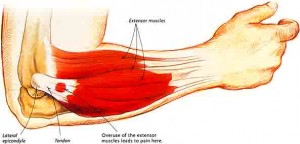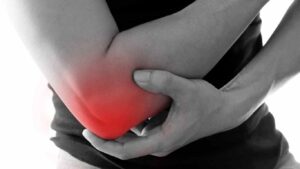What is tennis elbow?
By Physio Simon Mead
 Lateral epicondylitis or
Lateral epicondylitis or
lateral epicondylalgia, commonly known as “tennis elbow” is an overuse injury that occurs on the lateral (outside) aspect of your elbow. It affects the forearm extensor tendon (the tendon that attaches the muscles on the back of your forearm to the bone) at its attachment to the lateral epicondyle (the bony prominence on the outer edge of your elbow).
The extensor tendon becomes painful due to microscopic changes within the tendon fibres as they become swollen and disorganised. If the pain continues for a long period of time then the extensor tendon will become degenerative and may also result in small tears with in the tendon itself.
What causes tennis elbow?
Tennis elbow is an overuse injury caused by excessive use of the forearm extensor muscles. This overuse occurs in any activity that requires grasping or repetitive movement of the forearm, such as tennis, rowing, kayaking, typing, hammering, painting, repetitive lifting or gripping activities etc.
Excessive overload of the extensor tendon during sport and work generally occurs as a result of poor technique (such as a poor back hand shot in tennis) or a change in training equipment (ie. a thicker gripped tennis racquet). It can also occur after a sudden increase in training/work load that the extensor tendon cannot cope with.
Symptoms
 Pain on the lateral (outside) aspect of the elbow, particularly with grasping and gripping activities or racquet sports (this includes golf). This pain can often radiate down into the forearm muscles.
Pain on the lateral (outside) aspect of the elbow, particularly with grasping and gripping activities or racquet sports (this includes golf). This pain can often radiate down into the forearm muscles.- Point tenderness over the lateral epicondyle (the bony prominence on the outer edge of the elbow).
- Reduced grip strength and weakness with picking up objects.
- Morning stiffness.
Treatment
Treatment of tennis elbow firstly involves settling the current symptoms, and then secondly identifying the causes of the extensor tendon overload to reduce the risk of the pain returning.
To reduce the symptoms you need to avoid aggravating factors, de-load the tendon via the use of a brace or strapping and also change your training load. Your physiotherapist will also aid with pain relief with soft tissue release of your extensor muscles, elbow joint mobilisations and strapping.
Once the pain has subsided the causes of the extensor tendon overload needs to be identified. This can be done with a video analysis of your technique, overview of your training load and a thorough assessment from your physiotherapist on your biomechanics, flexibility, strength, training technique and equipment being used.
If you are experiencing any elbow pain, or you feel that your are at risk of developing tennis elbow then please feel free to see one of our physiotherapists for a thorough assessment of your elbow, biomechanics and training technique, phone 07 5500 6470 for an appointment.

































